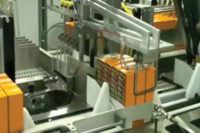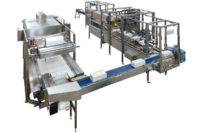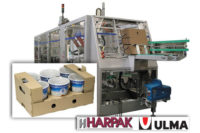Secondary packaging is designed to protect not only the dairy product, but also the primary packaging, which is typically the packaging most visible to the consumer in retail displays. Secondary packaging machines collect individual packages and place them in cartons that will eventually find their way onto pallets. The pallets will be shrink-wrapped, trucked to a warehouse or distribution center. They will eventually be delivered to a retail outlet where the pallet will be broken down, cartons opened and individual packages placed on the shelf. In other words, the secondary package is well-traveled and needs to be able to stand up to a lot of over-the-road abuse.
It’s important to find the right equipment to achieve your packing goals. Cost, speed, effectiveness and space on the manufacturing floor will likely be factors. So will reliability and maintenance. In this article we review what dairy processors should look for when choosing secondary packaging equipment.
Bottom loaders and wrap-around cartoners
The benefits of using automated secondary packaging includes increased speed, preventing injuries, enhanced reliability and better workplace safety, according to Bosch Packaging Technology. The company also points out that other important factors to consider are available floor space, bag and case flow and bag characteristics. (See more in the infographic). Bosch’s cartoner can produce up to 400 cartons per minute depending on pitch, and also uses less paperboard material.
A wrap-around case packer automatically erects, loads and closes wrap-around cases, trays, tray-lid combinations and regular slotted cases (RSC). According to BluePrint Automation (BPA), a wrap-around case packer is ideal for individually wrapped cheese, pouches with and without caps, bottles, cartons and retail-ready packaging.
The wrap-around case packer from BPA can pack 30 boxes per minute. Blanks are grabbed and erected by a twin vacuum arm system. The system is provided with a frequency-controlled motor drive, which guarantees accurate erection of the blank. Product is collated into a group using a customized two-axis gantry-style robot. Once collated, product is side-loaded into the erected wrap-around case. Hot melt glue is applied and flaps are securely closed. This case packer solution has a hygienic design that provides a fast and tool-free changeover.
A wrap-around cartoner from Kliklok-Woodman is ideal for liquid and viscous foods in cups or other rigid containers that are arranged singularly or in multiples or even stacked, according to Bosch.
Bottom-loading vertical case packers handle products gently, according to Schneider Packaging Equipment Co. A bottom-loading vertical case packer is particularly beneficial to dairy applications using gable-top cartons or gallon jugs. Equipment can be painted or made in heavy-washdown stainless steel.
A top-load case packer for pouches, bags, and flow-wrapped products can help product manufacturers fill cases quickly, according to Edson Packaging Machinery. This equipment can feed an integrated case erector and sealer to create a fully automatic operation. New equipment has a small footprint, so it can be placed into tight quarters. Flexible and cost-effective machines can pick 20 flexible packages per minute or as many as 10 cases per minute.
Easy-to-service design
New open designs allow machine operators increased access to internal workings. They can then easily identify and diagnose maintenance needs more quickly and efficiently. Schneider Packaging’s newly designed vertical case packer uses servo-motion, minimizing maintenance and minimizing the number of wearable parts. This technology reduces energy usage and decreases overall maintenance costs, according to the company. The machine also has an embedded intelligent LED lighting system to give operators visual cues about the machine, such as low product levels, low case magazines, product jams and tripped safety circuits. With this technology, operators and maintenance workers can easily locate where the attention is needed without having to first locate the human-machine interface and then troubleshoot the problem.
The speed, size and hygiene factors
Douglas Machine Inc. has a case packer that can package PET tubs at 46 cases per minute, providing high speed and high return. A lane divider distributes the tubs between four lanes before dual pick-and- place loaders arrange the tubs into single or stacked patterns.






